Contrafreeloading Indicating the Behavioural Need to Forage in Healthy and Feather Damaging Grey Parrots
Abstract
:Simple Summary
Abstract
1. Introduction
2. Materials and Methods
2.1. Ethical Approval
2.2. Animals
2.3. Housing and Nutrition
2.4. Acclimatization Period
2.5. Contrafreeloading Trial
2.6. Video Recording and Analysis of the Behaviour
2.7. Analysis of Contrafreeloading
2.8. Plumage Scoring
2.9. Statistical Analysis
3. Results
3.1. Food Intake
3.2. Foraging Times
3.3. Choice and Preference for Foraging Options
3.4. Investment in Contrafreeloading
3.5. Time Spent on Preening
3.6. Plumage Condition, FDB, and Its Relationship to CFL
4. Discussion
5. Conclusions
Supplementary Materials
Author Contributions
Funding
Institutional Review Board Statement
Informed Consent Statement
Data Availability Statement
Acknowledgments
Conflicts of Interest
References
- Inglis, I.R.; Forkman, B.; Lazarus, J. Free food or earned food? A review and fuzzy model of contrafreeloading. Anim. Behav. 1997, 53, 1171–1191. [Google Scholar] [CrossRef] [Green Version]
- Jensen, E.D. Preference for bar pressing over free-loading as a function of number of unrewarded presses. J. Exp. Psychol. 1963, 65, 451–454. [Google Scholar] [CrossRef]
- Ferreira Arza, Y.; Walker, J.D. Effects of increased fixed ratio magnitudes on contrafreeloading in laboratory mice. Ajayu Órgano Difusión Científica Dep. Psicol. UCBSP 2009, 7, 22–44. [Google Scholar]
- Forkman, B. The foraging behaviour of Mongolian gerbils: A behavioural need or a need to know? Behaviour 1996, 133, 129–143. [Google Scholar] [CrossRef]
- Warburton, H.; Mason, G. Is out of sight out of mind? The effects of resource cues on motivation in mink, Mustela vison. Anim. Behav. 2003, 65, 755–762. [Google Scholar]
- De Leeuw, J. Stimulation of Behavioural and Nutritional Satiety in Pigs. Ph.D. Thesis, Wageningen University, Wageningen, The Netherlands, 2004. [Google Scholar]
- De Jonge, F.H.; Tilly, S.L.; Baars, A.M.; Spruijt, B.M. On the rewarding nature of appetitive feeding behaviour in pigs (Sus scrofa): Do domesticated pigs contrafreeload? Appl. Anim. Behav. Sci. 2008, 114, 359–372. [Google Scholar] [CrossRef] [Green Version]
- Van Os, J.M.; Mintline, E.M.; DeVries, T.J.; Tucker, C.B. Domestic cattle (Bos taurus taurus) are motivated to obtain forage and demonstrate contrafreeloading. PLoS ONE 2018, 13, e0193109. [Google Scholar] [CrossRef] [Green Version]
- Rosenberger, K.; Simmler, M.; Nawroth, C.; Langbein, J.; Keil, N. Goats work for food in a contrafreeloading task. Sci. Rep. 2020, 10, 22336. [Google Scholar] [CrossRef]
- Sasson-Yenor, J.; Powell, D.M. Assessment of contrafreeloading preferences in giraffe (Giraffa camelopardalis). Zoo Biol. 2019, 38, 414–423. [Google Scholar] [CrossRef]
- McGowan, R.T.S.; Robbins, C.T.; Alldredge, J.R.; Newberry, R.C. Contrafreeloading in Grizzly bears: Implications for captive foraging enrichment. Zoo Biol. 2009, 29, 484–502. [Google Scholar] [CrossRef]
- Da Silva Vasconcellos, A.; Harumi Adania, C.; Ades, C. Contrafreeloading in maned wolves: Implications for their management and welfare. Appl. Anim. Behav. Sci. 2012, 140, 85–91. [Google Scholar] [CrossRef]
- Menzel, E.W. Chimpanzees (Pan troglodytes): Problem seeking versus the bird-in-hand, least-effort strategy. Primates 1991, 32, 497–508. [Google Scholar] [CrossRef]
- Reinhardt, V. Caged rhesus macaques voluntarily work for ordinary food. Primates 1994, 35, 95–98. [Google Scholar] [CrossRef]
- Ogura, T. Contrafreeloading and the value of control over visual stimuli in Japanese macaques (Macaca fuscata). Anim. Cogn. 2011, 14, 427–431. [Google Scholar] [CrossRef] [Green Version]
- Baenninger, R.; Mattleman, R.A. Visual reinforcement: Operant acquisition in the presence of a free mirror. Anim. Learn. Behav. 1973, 1, 302–306. [Google Scholar] [CrossRef]
- Powell, R.W. Comparative studies of preference for free vs response-produced reinforcers. Anim. Learn. Behav. 1974, 2, 185–188. [Google Scholar] [CrossRef] [Green Version]
- Bean, D.; Mason, G.J.; Bateson, M. Contrafreeloading in starlings: Testing the information hypothesis. Behaviour 1999, 136, 1267–1282. [Google Scholar] [CrossRef]
- Neuringer, A.J. Animals respond for food in the presence of free food. Science 1969, 166, 399–401. [Google Scholar] [CrossRef]
- Lindqvist, C.E.S.; Schütz, K.E.; Jensen, P. Red jungle fowl have more contrafreeloading than white leghorn layers: Effect of food deprivation and consequences for information gain. Behaviour 2002, 139, 1195–1209. [Google Scholar] [CrossRef]
- Lindqvist, C.E.S.; Jensen, P. Domestication and stress effects on contrafreeloading and spatial learning performance in red jungle fowl (Gallus gallus) and white leghorn layers. Behav. Process. 2009, 81, 80–84. [Google Scholar] [CrossRef]
- Rozek, J.C.; Millam, J.R. Preference and motivation for different diet forms and their effect on motivation for a foraging enrichment in captive Orange-winged Amazon parrots (Amazona amazonica). Appl. Anim. Behav. Sci. 2011, 129, 153–161. [Google Scholar] [CrossRef]
- Smith, G.E.; Greene, D.; Hartsfield, L.A.; Pepperberg, I.M. Initial evidence for eliciting contrafreeloading in grey parrots (Psittacus erithacus) via the opportunity for playful foraging. J. Comp. Psychol. 2021, 135, 516–533. [Google Scholar] [CrossRef]
- Smith, G.E.; Bastos, A.P.; Chodorow, M.; Taylor, A.H.; Pepperberg, I.M. Contrafreeloading in kea (Nestor notabilis) in comparison to Grey parrots (Psittacus erithacus). Sci. Rep. 2022, 12, 17415. [Google Scholar] [CrossRef]
- Coulton, L.E.; Waran, N.K.; Young, R.J. Effects of foraging enrichment on the behaviour of parrots. Anim. Welf. 1997, 6, 357–363. [Google Scholar] [CrossRef]
- Osborne, S.R. The free food (contrafreeloading) phenomenon: A review and analysis. Anim. Learn. Behav. 1977, 5, 221–235. [Google Scholar] [CrossRef] [Green Version]
- Lindqvist, C.E.S.; Jensen, P. Effects of age, sex and social isolation on contrafreeloading in red junglefowl (Gallus gallus) and white leghorn fowl. Appl. Anim. Behav. Sci. 2008, 114, 419–428. [Google Scholar] [CrossRef]
- Morgan, M.J. Do rats like to work for their food? Learn. Motiv. 1974, 5, 352–368. [Google Scholar] [CrossRef]
- Inglis, I.R.; Shepherd, D.S. Rats work for food they then reject: Support for the information-primacy approach to learned industriousness. Ethology 1994, 98, 154–164. [Google Scholar] [CrossRef]
- Amato, D.; Milella, M.S.; Badiani, A.; Nencini, P. Compulsive-like effects of repeated administration of quinpirole on drinking behavior in rats. Behav. Brain Res. 2006, 172, 1–13. [Google Scholar] [CrossRef]
- Stephens, D.W.; Krebs, J.R. Foraging Theory; Princeton University Press: Princeton, NJ, USA, 1986. [Google Scholar]
- Inglis, I.R.; Langton, S.; Forkman, B.; Lazarus, J. An information primacy model of exploratory and foraging behaviour. Anim. Behav. 2001, 62, 543–557. [Google Scholar] [CrossRef] [Green Version]
- Inglis, I.R. Towards a cognitive theory of exploratory behaviour. In Exploration in Animals and Humans; Archer, J., Burke, L., Eds.; Van Nostrand Reinhold: London, UK, 1983; pp. 72–116. [Google Scholar]
- Inglis, I.R.; Ferguson, N.J.K. Starlings search for food rather than eat freely available, identical food. Anim. Behav. 1986, 34, 614–617. [Google Scholar] [CrossRef]
- Carder, B.; Berkowitz, K.I. Rats preference for earned in comparison with free food. Science 1970, 167, 1273–1274. [Google Scholar] [CrossRef]
- Tarte, R.D.; Vernon, C.R. Rats barpressing in the presence of free food as a function of fixed-ratio schedules. Bull. Psychon. Soc. 1974, 3, 34–36. [Google Scholar] [CrossRef] [Green Version]
- Feild, C.L.; Kasper, S.; Mitchell, D. Effort and contrafreeloading. Bull. Psychon. Soc. 1984, 22, 147–150. [Google Scholar] [CrossRef] [Green Version]
- Tarte, R.D. Contrafreeloading in humans. Psychol. Rep. 1981, 49, 859–866. [Google Scholar] [CrossRef]
- Andrews, C.; Viviani, J.; Egan, E.; Bedford, T.; Brilot, B.; Nettle, D.; Bateson, M. Early life adversity increases foraging and information gathering in European starlings, Sturnus vulgaris. Anim. Behav. 2015, 109, 123–132. [Google Scholar] [CrossRef] [Green Version]
- Lindqvist, C.; Zimmerman, P.; Jensen, P. A note on contrafreeloading in broilers compared to layer chicks. Appl. Anim. Behav. Sci. 2006, 101, 161–166. [Google Scholar] [CrossRef]
- Höhne, A.; Petow, S.; Bessei, W.; Schrader, L. Contrafreeloading and foraging-related behavior in hens differing in laying performance and phylogenetic origin. Poult. Sci. 2023, 102, 102489. [Google Scholar] [CrossRef]
- Lentz, B.E.; Cohen, S.L. The effect of prior training on the contrafreeloading phenomenon. Bull. Psychon. Soc. 1980, 15, 48–50. [Google Scholar] [CrossRef] [Green Version]
- Kleinman, K.M.; McLaughlin, R.J.; Gerard, I.V.; Boxza, D.A.; Clipper, R.C. Rats’ preference for the more effortful of two responses as a function of prior training. Psychol. Rep. 1976, 38, 931–937. [Google Scholar] [CrossRef]
- Taylor, G.T. A limitation of the contrafreeloading phenomenon. Psychon. Sci. 1972, 29, 173–174. [Google Scholar] [CrossRef] [Green Version]
- Knutson, J.R.; Carlson, C.W. Operant responding with free access to the reinforcer: A replication and extension. Anim. Learn. Behav. 1973, 2, 133–136. [Google Scholar] [CrossRef] [Green Version]
- Davis, S.F.; Beighley, B.G.; Libretto, J.S.; Mollenhour, M.J.; Prytula, R.E. Contrafreeloading as a function of early environmental conditions. Bull. Psychon. Soc. 1975, 65, 95–97. [Google Scholar] [CrossRef] [Green Version]
- Coburn, J.F.; Tarte, R.D. The effect of rearing environment on the contrafreeloading phenomenon in rats. J. Exp. Anal. Behav. 1976, 26, 289–294. [Google Scholar] [CrossRef]
- Tarte, R.D.; Townsend, S.G.; Vernon, C.R. Housing environments and the barpressing vs freeloading phenomenon in rats. Bull. Psychon. Soc. 1973, 2, 69–71. [Google Scholar] [CrossRef]
- Inglis, I.R.; Freeman, N.H. Reversible effects of ambient housing stimulation upon stimulation-seeking in rats. Q. J. Exp. Psychol. 1976, 28, 409–417. [Google Scholar] [CrossRef]
- Garner, J.P. Stereotypies and other abnormal repetitive behaviors: Potential impact on validity, reliability, and replicability of scientific outcomes. ILAR J. 2005, 46, 106–117. [Google Scholar] [CrossRef] [Green Version]
- Garner, J.P. Perseveration and stereotypy: Systems-level insights from clinical psychology. In Stereotypic Animal Behavior: Fundamentals and Applications to Welfare, 2nd ed.; Mason, G., Rushen, J., Eds.; CAB International: Wallingford, UK, 2006; pp. 121–152. [Google Scholar]
- Sandson, J.; Albert, M.L. Varieties of perseveration. Neuropsychologia 1984, 22, 715–732. [Google Scholar] [CrossRef]
- Norman, D.A.; Shallice, T. Attention to action: Willed and automatic control of behaviour. In Consciousness and Self-Regulation: Advances in Research and Theory, Volume 4; Davidson, R.J., Schwartz, G.E., Shapiro, D., Eds.; Plenum Press: New York, NY, USA, 1986; pp. 1–18. [Google Scholar]
- Turner, M. Towards an executive dysfunction account of repetitive behaviour in autism. In Autism as an Executive Disorder; Russell, J., Ed.; Oxford University Press: New York, NY, USA, 1997; pp. 57–100. [Google Scholar]
- Garner, J.P.; Mason, G.J. Evidence for a relationship between cage stereotypies and behavioural disinhibition in laboratory rodents. Behav. Brain Res. 2002, 136, 83–92. [Google Scholar] [CrossRef] [Green Version]
- Garner, J.P.; Mason, G.; Smith, R. Stereotypic route-tracing in experimentally-caged songbirds correlates with general behavioural disinhibition. Anim. Behav. 2003, 66, 711–727. [Google Scholar] [CrossRef] [Green Version]
- Garner, J.P.; Meehan, C.L.; Mench, J.A. Stereotypies in caged parrots, schizophrenia and autism: Evidence for a common mechanism. Behav. Brain Res. 2003, 145, 125–134. [Google Scholar] [CrossRef]
- Garner, J.P.; Wayne, C.M.; Würbel, H.; Mench, J.A. Barbering (whisker trimming) in laboratory mice involves the same brain systems as compulsive behaviors in trichotillomania, autism and other obsessive-compulsive spectrum disorders. In Proceedings of the 37th International Conference of the International Society for Applied Ethologists, Abano Terme, Italy, 24–28 June 2003; p. 75. [Google Scholar]
- Vickery, S.S.; Mason, G.J. Stereotypy in caged bears correlates with perseverative responding on an extinction task. Appl. Anim. Behav. Sci. 2005, 91, 247–260. [Google Scholar] [CrossRef] [Green Version]
- Grindlinger, H. Impulsive feather picking in birds. Arch. Gen. Psychiatry 1991, 48, 857. [Google Scholar] [CrossRef]
- Gaskins, L.A.; Bergman, L. Surveys of avian practitioners and pet owners regarding common behavior problems in psittacine birds. J. Avian Med. Surg. 2011, 25, 111–118. [Google Scholar] [CrossRef]
- Kinkaid, H.Y.M.; Mills, D.S.; Nichols, S.G.; Meagher, R.K.; Mason, G.J. Feather-damaging behaviour in companion parrots: An initial analysis of potential demographic risk factors. Avian Biol. Res. 2013, 6, 289–296. [Google Scholar] [CrossRef]
- Ebisawa, K.; Nakayama, S.; Pai, C.; Kinoshita, R.; Koie, H. Prevalence and risk factors for feather-damaging behavior in psittacine birds: Analysis of a Japanese nationwide survey. PLoS ONE 2021, 16, e0254610. [Google Scholar] [CrossRef]
- Harrison, G.J. Disorders of the integument. In Avian Medicine and Surgery: Principles and Application; Harrison, G.J., Harrison, L.R., Ritchie, B.W., Eds.; WB Saunders: Philadelphia, PA, USA, 1986; pp. 509–524. [Google Scholar]
- Nett, C.S.; Tully, T.N., Jr. Anatomy, clinical presentation and diagnostic approach to feather-picking pet birds. Comp. Cont. Ed. Pract. Vet. 2003, 25, 206–219. [Google Scholar]
- Van Zeeland, Y.R.A.; Schoemaker, N.J. Plumage disorders in psittacine birds, Part 2: Feather damaging behaviour. Eur. J. Companion Anim. Pract. 2014, 24, 24–36. [Google Scholar]
- Van Zeeland, Y.R.A.; Spruit, B.M.; Rodenburg, T.B.; Riedstra, B.; van Hierden, Y.M.; Buitenhuis, B.; Korte, S.M.; Lumeij, J.T. Feather damaging behaviour in parrots: A review with consideration of comparative aspects. Appl. Anim. Behav. Sci. 2009, 121, 75–95. [Google Scholar] [CrossRef]
- Van Hoek, C.S.; King, C.E. Causation and influence of environmental enrichment on feather picking of the crimson-bellied conure (Pyrrhura perlata perlata). Zoo Biol. 1997, 16, 161–172. [Google Scholar] [CrossRef]
- Meehan, C.L.; Millam, J.R.; Mench, J.A. Foraging opportunity and increased physical complexity both prevent and reduce psychogenic feather picking by young Amazon parrots. Appl. Anim. Behav. Sci. 2003, 80, 71–85. [Google Scholar] [CrossRef]
- Lumeij, J.T.; Hommers, C.J. Foraging ‘enrichment’ as treatment for pterotillomania. Appl. Anim. Behav. Sci. 2008, 111, 85–94. [Google Scholar] [CrossRef]
- Snyder, N.F.R.; Wiley, J.W.; Kepler, C.B. The Parrots of Luquillo: Natural History and Conservation of the Puerto Rican Parrot; The Western Foundation of Vertebrate Zoology: Los Angeles, CA, USA, 1987; p. 7. [Google Scholar]
- Gilardi, J.D.; Munn, C.A. Patterns of activity, flocking, and habitat use in parrots of the Peruvian Amazon. Condor 1998, 100, 641–653. [Google Scholar] [CrossRef]
- Symes, C.T.; Perrin, M.R. Daily flight activity and flocking behaviour patterns of the greyheaded parrot (Poicephalus fuscicollis suahelicus) Reichenow 1898 in Northern Province, South Africa. Trop. Zool. 2003, 16, 47–62. [Google Scholar] [CrossRef] [Green Version]
- Salinas-Melgoza, A.; Renton, K. Seasonal varaiation in activity patterns of juvenile lilac-crowned parrots in tropical dry forest. Wilson Bull. 2005, 117, 291–295. [Google Scholar] [CrossRef]
- O’Hara, M.; Mioduszewska, B.; Haryoko, T.; Prawiradilaga, D.M.; Huber, L.; Auersperg, A. Extraction without tooling around-The first comprehensive description of the foraging- and socio-ecology of wild goffin’s cockatoos (Cacatua goffiniana). Behaviour 2019, 156, 661–690. [Google Scholar] [CrossRef] [Green Version]
- Oviatt, L.A.; Millam, J.R. Breeding behaviour of captive Orange-winged Amazon parrots. Exotic Bird. Rep. 1997, 9, 6–7. [Google Scholar]
- Rozek, J.C.; Danner, L.M.; Stucky, P.A.; Millam, J.R. Over-sized pellets naturalize foraging time of captive Orange-winged Amazon parrots (Amazona amazonica). Appl. Anim. Behav. Sci. 2010, 125, 80–87. [Google Scholar] [CrossRef]
- Van Zeeland, Y.R.A.; Schoemaker, N.J.; Ravesteijn, M.M.; Mol, M.; Lumeij, J.T. Efficacy of foraging enrichments to increase foraging time in Grey parrots (Psittacus erithacus erithacus). Appl. Anim. Behav. Sci. 2013, 149, 87–102. [Google Scholar] [CrossRef]
- Jenkins, J.R. Feather picking and self-mutilation in psittacine birds. Vet. Clin. N. Am. Exot. Anim. Pract. 2001, 4, 651–667. [Google Scholar] [CrossRef]
- Rubinstein, J.; Lightfoot, T. Feather loss and feather destructive behavior in pet birds. J. Exotic Pet. Med. 2012, 21, 219–234. [Google Scholar] [CrossRef]
- Rodríguez-López, R. Environmental enrichment for parrot species: Are we squawking up the wrong tree? Appl. Anim. Behav. Sci. 2016, 180, 1–10. [Google Scholar] [CrossRef] [Green Version]
- Hughes, B.O.; Duncan, I.J.H. The notion of ethological “need”, models of motivation and animal welfare. Anim. Behav. 1988, 36, 1696–1707. [Google Scholar] [CrossRef]
- Jensen, P.; Toates, F.M. Who needs ‘behavioural needs’? Motivational aspects of the needs of animals. Appl. Anim. Behav. Sci. 1993, 37, 161–181. [Google Scholar] [CrossRef]
- Mills, D.S. Medical paradigms for the study of problem behaviour: A critical review. Appl. Anim. Behav. Sci. 2003, 81, 265–277. [Google Scholar] [CrossRef]
- Lewis, M.H.; Gluck, J.P.; Beauchamp, A.J.; Keresztury, M.F. Long-term effects of early social isolation in Macaca mulatta: Changes in dopamine receptor function following apomorphine challenge. Brain Res. 1990, 513, 67–73. [Google Scholar] [CrossRef] [Green Version]
- Jones, G.H.; Marsden, C.A.; Robbins, T.W. Behavioral rigidity and rule-learning deficits following isolation-rearing in the rat—Neurochemical correlates. Behav. Brain Res. 1991, 43, 35–50. [Google Scholar] [CrossRef]
- Würbel, H. Ideal homes? Housing effects on rodent brain and behaviour. Trends Neurosci. 2001, 24, 207–211. [Google Scholar] [CrossRef]
- Meehan, C.L.; Garner, J.P.; Mench, J.A. Environmental enrichment and development of cage stereotypy in Orange-winged Amazon parrots (Amazona amazonica). Dev. Psychobiol. 2004, 44, 209–218. [Google Scholar] [CrossRef]
- Joseph, L. Contrafreeloading and its benefits to avian behavior. In Proceedings of the Association of Avian Veterinarians, Milwaukee, WI, USA, 10–13 August 2009; pp. 399–401. [Google Scholar]
- Briscoe, J.A.; Wilson, L.; Smith, G. Non-medical risk factors for feather picking in pet parrots. In Proceedings of the Annual Meeting of the Association of Avian Veterinarians, Orlando, FL, USA, 22–24 August 2001; p. 131. [Google Scholar]
- Seibert, L.M. Feather-picking disorder in pet birds. In Manual of Parrot Behavior; Luescher, A.U., Ed.; Blackwell Publishing: Oxford, UK, 2006; pp. 255–265. [Google Scholar]
- Jayson, S.L.; Williams, D.L.; Wood, J.L. Prevalence and risk factors of feather plucking in African grey parrots (Psittacus erithacus erithacus and Psittacus erithacus timneh) and cockatoos (Cacatua spp.). J. Exotic Pet. Med. 2014, 23, 250–257. [Google Scholar] [CrossRef]
- Gaskins, L.A.; Hungerford, L. Nonmedical factors associated with feather picking in pet psittacine birds. J. Avian Med. Surg. 2014, 28, 109–117. [Google Scholar] [CrossRef]
- Chapman, C.A.; Chapman, L.J.; Wrangham, R. Observations on the feeding biology and population ecology of the grey parrot Psittacus erithacus. Scopus 1993, 16, 89–93. [Google Scholar]
- Juniper, T.; Parr, M. Parrots, a Guide to Parrots of the World; Yale University Press: New Haven, CT, USA, 1998. [Google Scholar]
- Forshaw, J.M.; Cooper, W.T. Parrots of the World; Hancock House Publishers: Surry, UK, 2000. [Google Scholar]
- May, D.L. Grey parrots of the Congo basin forest. PsittaScene 2001, 13, 8–10. [Google Scholar]
- Pepperberg, I.M. Cognitive and communicative abilities of Grey parrots. Appl. Anim. Behav. Sci. 2006, 100, 77–86. [Google Scholar] [CrossRef] [Green Version]
- Davis, C.S. Appreciating avian intelligence: The importance of a proper domestic environment. J. Am. Vet. Med. Assoc. 1998, 212, 1220–1222. [Google Scholar]
- Graham, D.L. Pet birds: Historical and modern perspectives on the keeper and the kept. J. Am. Vet. Med. Assoc. 1998, 212, 1216–1219. [Google Scholar]
- May, D. Frei lebende Graupapageien im Kongobecken. Teil 1. Papageien 2002, 9, 310–313. [Google Scholar]
- May, D. Frei lebende Graupapegeien im Kongobecken. Teil 2. Papegeien 2002, 10, 350–355. [Google Scholar]
- Kruzer, A. Bird Cage Sizes and Bar Spacing: Your Bird Should Have Room to Exercise. Last Updated on 09/29/2019. Available online: https://www.thesprucepets.com/bird-cage-sizes-4065662. (accessed on 21 July 2023).
- Williams, I.; Hoppitt, W.; Grant, R. The effect of auditory enrichment, rearing method and social environment on the behavior of zoo-housed psittacines (Aves: Psittaciformes); implications for welfare. Appl. Anim. Behav. Sci. 2017, 186, 85–92. [Google Scholar] [CrossRef]
- Gupfinger, R.; Kaltenbrunner, M. The design of musical instruments for grey parrots: An artistic contribution toward auditory enrichment in the context of ACI. Multimodal Technol. Interact. 2020, 4, 16. [Google Scholar] [CrossRef]
- Beekmans, M.H.C.; Vinke, C.M.; Maijer, A.; de Haan, I.; Schoemaker, N.J.; Rodenburg, T.B.; Kooistra, H.S.; van Zeeland, Y.R.A. Increasing foraging times with appetitive and consummatory foraging enrichment in grey parrots (Psittacus erithacus). Appl. Anim. Behav. Sci. 2023, 265, 105986. [Google Scholar] [CrossRef]
- Portney, L.G.; Watkins, M.P. Foundations of Clinical Research: Applications to Practice, 3rd ed.; Prentice Hall Health: Upper Saddle River, NJ, USA, 2008. [Google Scholar]
- Van Zeeland, Y.R.A.; Bergers, M.J.; van der Valk, L.; Schoemaker, N.J.; Lumeij, J.T. Evaluation of a novel feather scoring system for monitoring feather damaging behaviour in parrots. Vet. J. 2012, 196, 247–252. [Google Scholar] [CrossRef]
- Fry, C.H.; Keith, S.; Urban, E.K. The Birds of Africa; Princeton University Press: Princeton, NJ, USA, 1988; Volume 3. [Google Scholar]
- Elson, H.L.G.; Marples, N.M. How captive parrots react to foraging enrichments. In Proceedings of the 3rd Annual Symposium on Zoo Research, Chester, UK, 9–10 July 2001; Wehnelt, S., Hudson, C., Eds.; pp. 1–8. [Google Scholar]
- Malmkvist, J.; Palme, R.; Svendsen, P.M.; Hansen, S.W. Additional foraging elements reduce abnormal behaviour–fur-chewing and stereotypic behaviour–in farmed mink (Neovison vison). Appl. Anim. Behav. Sci. 2013, 149, 77–86. [Google Scholar] [CrossRef]
- Mellor, E.L.; McDonald Kinkaid, H.K.; Mendl, M.T.; Cuthill, I.C.; van Zeeland, Y.R.A.; Mason, G.J. Nature calls: Intelligence and natural foraging style predict poor welfare in captive parrots. Proc. R. Soc. B 2021, 288, 20211952. [Google Scholar] [CrossRef]
- Fraser, D.; Matthews, L.R. Preference and motivation testing. In Animal Welfare; Appleby, M.C., Hughes, B.O., Eds.; CAB International: New York, NY, USA, 1997; pp. 159–173. [Google Scholar]
- Luescher, A.U. Manual of Parrot Behavior; Blackwell Publishing: Oxford, UK, 2006. [Google Scholar]
- Del Hoyo, L.; Elliot, A.; Sargatal, J. Handbook of the Birds of the World; Lynx Edicions: Barcelona, Spain, 1997; Volume 4. [Google Scholar]
- Athan, M.S. Guide to Companion Parrot Behavior; Barron’s Educational Series: Hauppage, NY, USA, 1999. [Google Scholar]
- Sebastián-González, E.; Hiraldo, F.; Blanco, G.; Hernandez-Brito, D.; Romero-Vidal, P.; Carrete, M.; Gómez-Llanos, E.; Pacífico, E.C.; Díaz-Luque, J.A.; Tella, J.L. The extent, frequency and ecological functions of food wasting by parrots. Sci. Rep. 2019, 9, 15280. [Google Scholar] [CrossRef] [Green Version]
- Kuba, M.J.; Byrne, R.A.; Meisel, D.V.; Mather, J.A. When do octopuses play? Effects of repeated testing, object type, age and food deprivation on object play in Octopus vulgaris. J. Comp. Psychol. 2006, 120, 184–190. [Google Scholar] [CrossRef] [Green Version]
- Goodman, A. Addiction: Definition and implications. Br. J. Addict. 1990, 85, 1403–1408. [Google Scholar] [CrossRef]
- Rachman, S.; Shafran, R. Cognitive and behavioural features of obsessive-compulsive disorder. In Obsessive-Compulsive Disorder: Theory, Research and Treatment; Swinson, R.P., Ed.; The Guilford Press: New York, NY, USA, 1998; pp. 51–78. [Google Scholar]
- Orford, J. Conceptualizing addiction: Addiction as excessive appetite. Addiction 2001, 96, 15–31. [Google Scholar] [CrossRef] [Green Version]
- Volkow, N.D.; Fowler, J.S. Addiction, a disease of compulsion and drive: Involvement of the orbitofrontal cortex. Cereb. Cortex 2000, 10, 318–325. [Google Scholar] [CrossRef]
- Mason, G.; Rushen, J. Stereotypic Animal Behavior: Fundamentals and Applications to Welfare, 2nd ed.; CAB International: Wallingford, UK, 2006. [Google Scholar]
- Langen, M.; Kas, M.J.; Staal, W.G.; van Engeland, H.; Durston, S. The neurobiology of repetitive behavior: Of mice. Neurosci. Biobehav. Rev. 2011, 35, 345–355. [Google Scholar] [CrossRef]
- Fischer, A.G.; Ullsperger, M. An update on the role of serotonin and its interplay with dopamine for reward. Front. Hum. Neurosci. 2017, 11, 484. [Google Scholar] [CrossRef] [Green Version]
- Rogers, R.D. The roles of dopamine and serotonin in decision making: Evidence from pharmacological experiments in humans. Neuropsychopharmacology 2011, 36, 114–132. [Google Scholar] [CrossRef] [Green Version]
- Dias, R.; Robbins, T.W.; Roberts, A.C. Dissociation in prefrontal cortex of affective and attentional shifts. Nature 1996, 380, 69–72. [Google Scholar] [CrossRef]
- Birrell, J.M.; Brown, V.J. Medial frontal cortex mediates perceptual attentional set shifting in the rat. J. Neurosci. 2000, 20, 4320–4324. [Google Scholar] [CrossRef] [Green Version]
- Westerhof, I.; Lumeij, J.T. Feather picking in the African Grey parrot. In Proceedings of the European Symposium on Birds’ Diseases, Beerse, Belgium, 5–6 March 1987; Van Loen, A., Ed.; pp. 98–103. [Google Scholar]
- Meehan, C.L.; Mench, J.A. Environmental enrichment affects the fear and exploratory responses to novelty of young Amazon parrots. Appl. Anim. Behav. Sci. 2002, 79, 75–88. [Google Scholar] [CrossRef]
- Meehan, C.L.; Garner, J.P.; Mench, J.A. Isosexual pair housing improves the welfare of young Amazon parrots. Appl. Anim. Behav. Sci. 2003, 81, 73–88. [Google Scholar] [CrossRef]
- Zimbardo, P.G.; Montgomery, K.C. Effects of “free-environment” rearing upon exploratory behavior. Psychol. Rep. 1957, 3, 589–594. [Google Scholar]
- Woods, P.J.; Ruckelshaus, S.I.; Bowling, D.M. Some effects of “free” and “restricted” environmental rearing conditions upon adult behavior in the rat. Psychol. Rep. 1960, 6, 191–200. [Google Scholar] [CrossRef]
- Konrad, K.W.; Bagshaw, M. Effect of novel stimuli on cats reared in a restricted environment. J. Comp. Physiol. Psychol. 1970, 70, 157–164. [Google Scholar] [CrossRef]
- Inglis, I.R. Enriched sensory experience in adulthood increases subsequent exploratory behaviour in the rat. Anim. Behav. 1975, 23, 932–940. [Google Scholar] [CrossRef]

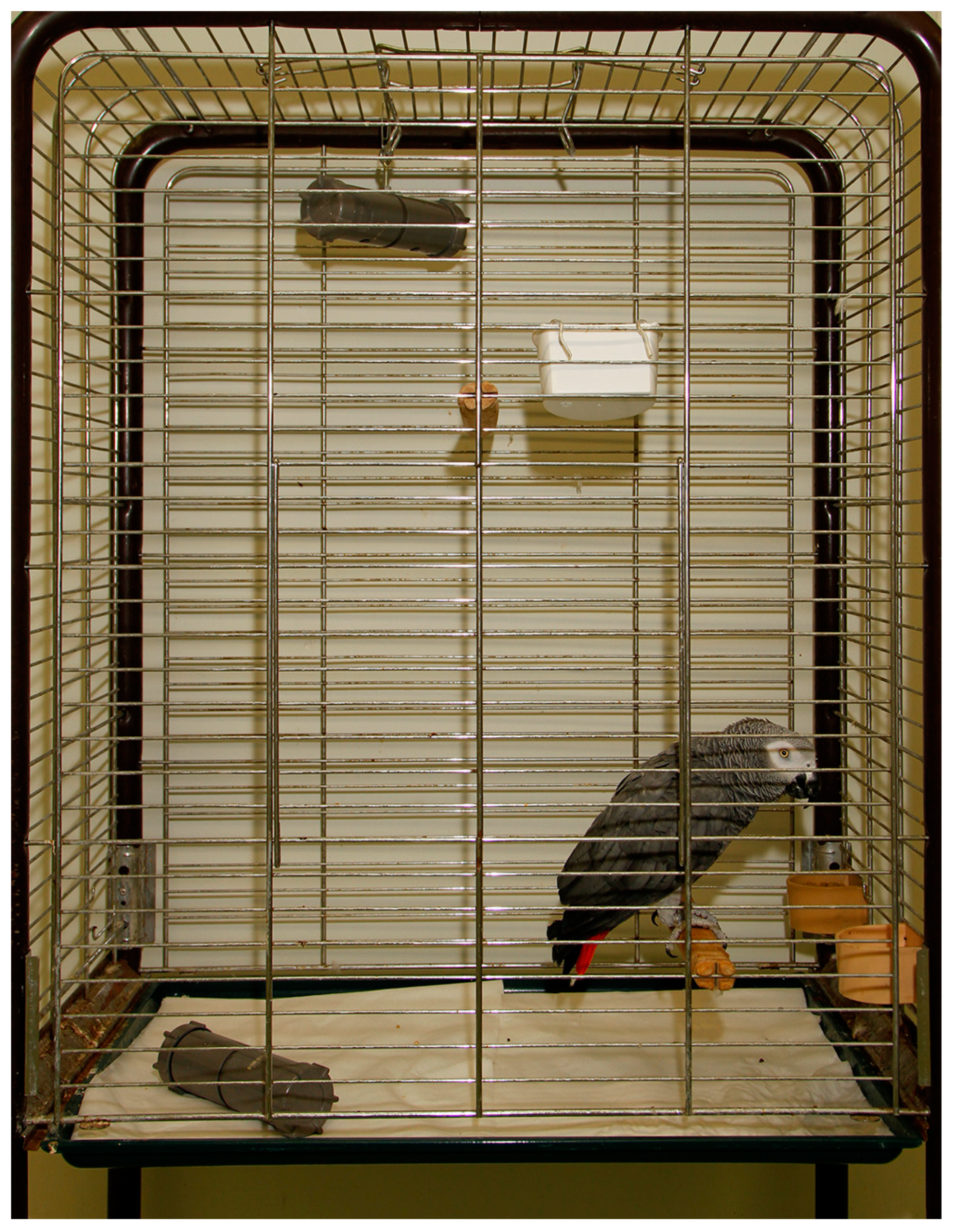
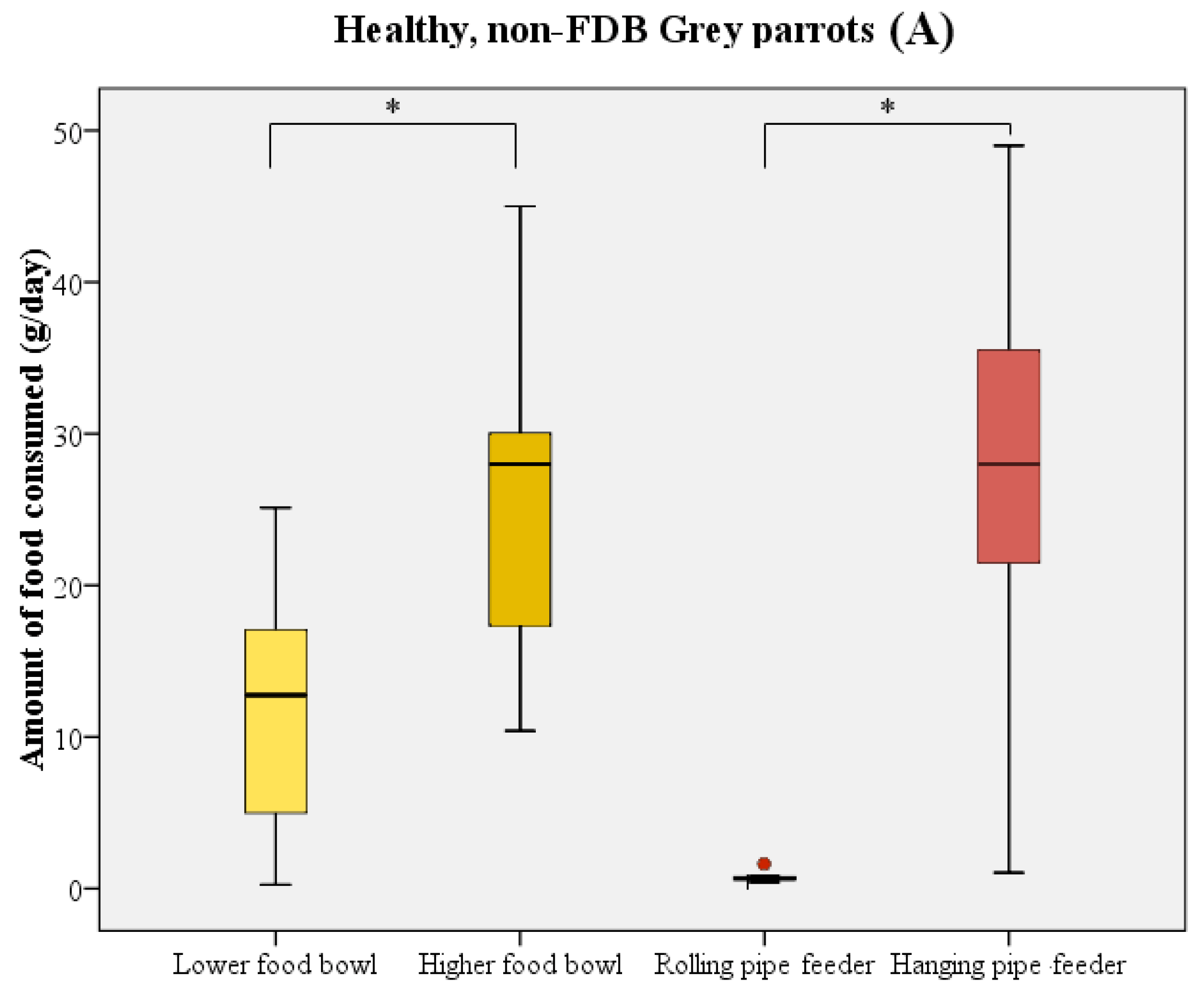
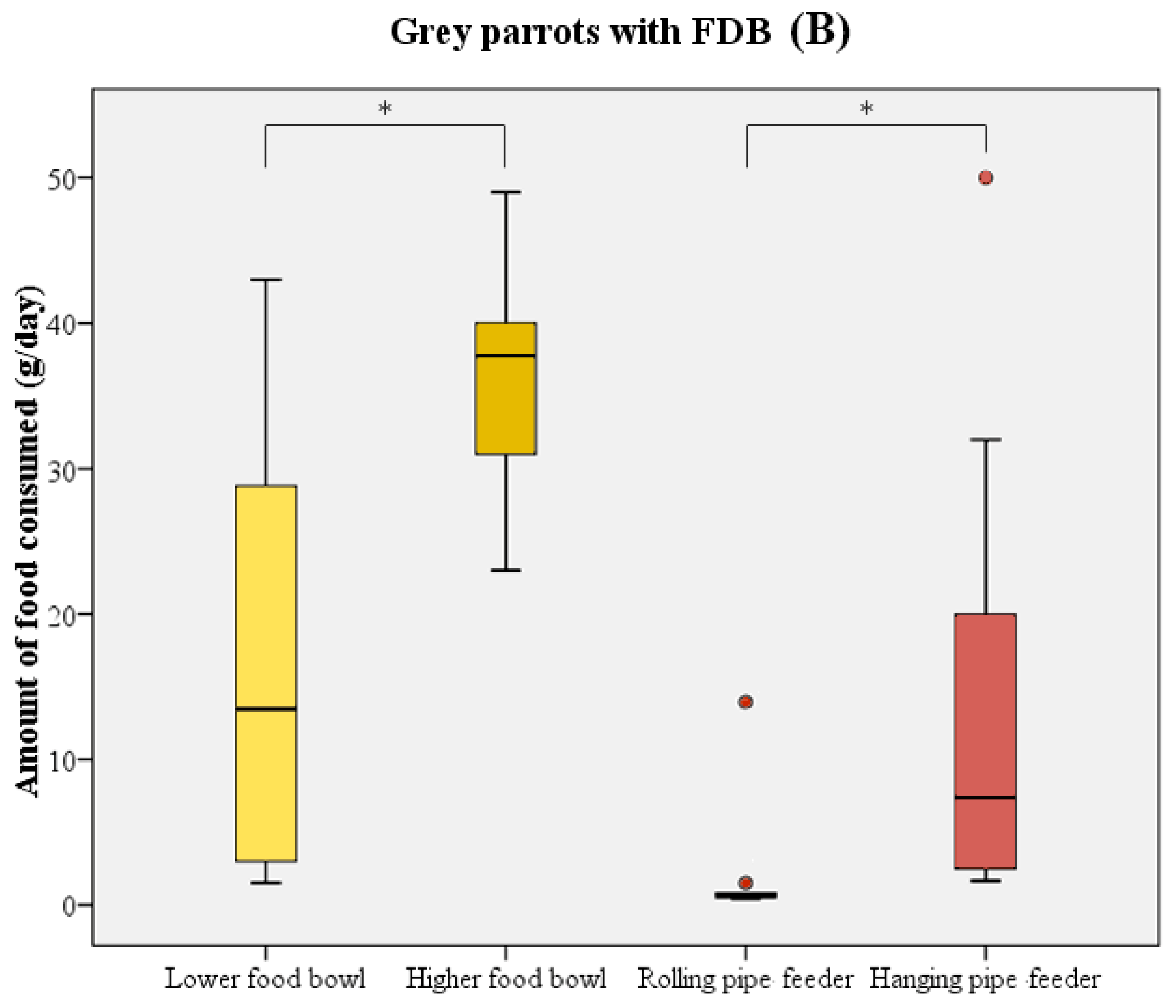
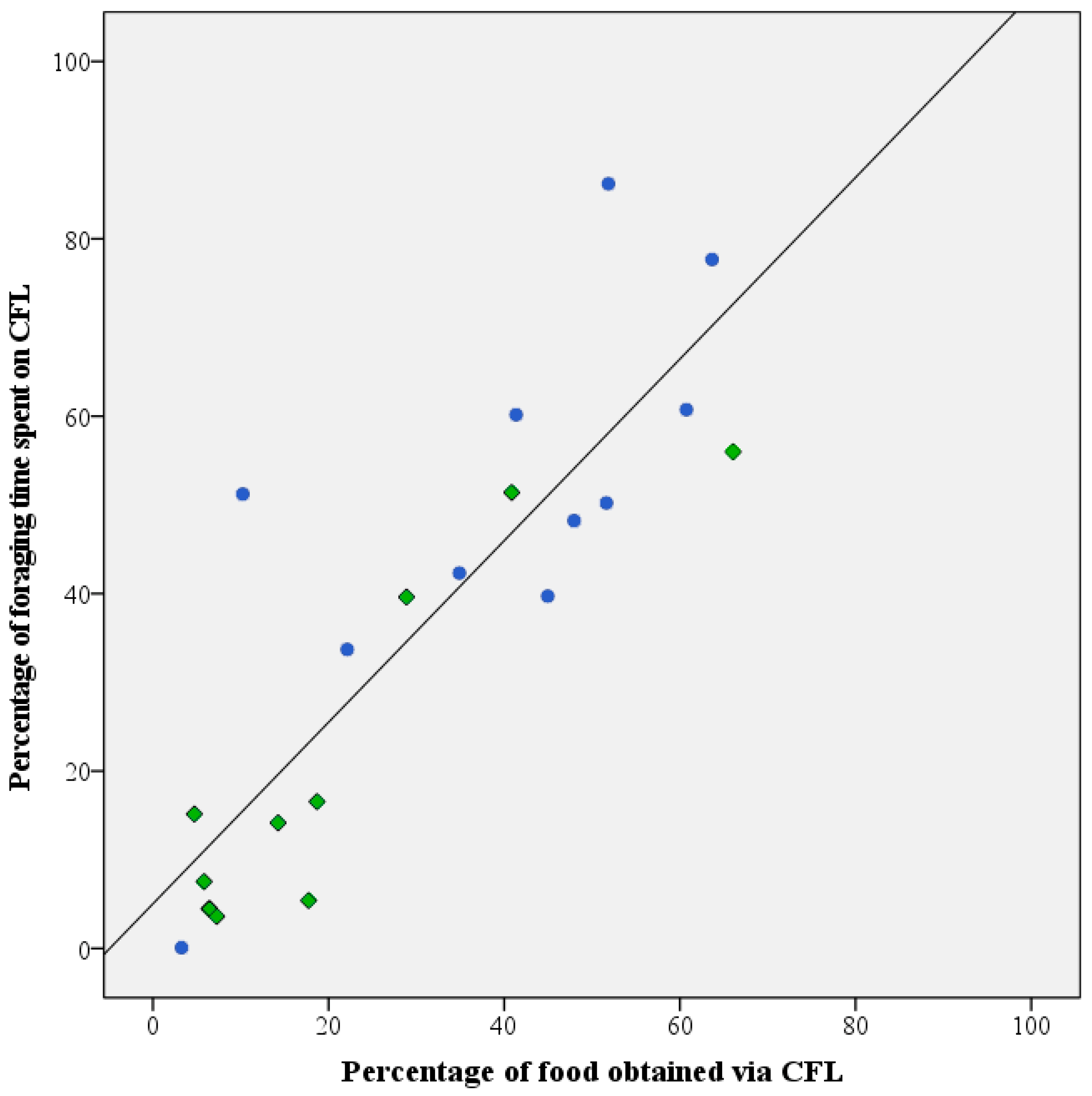
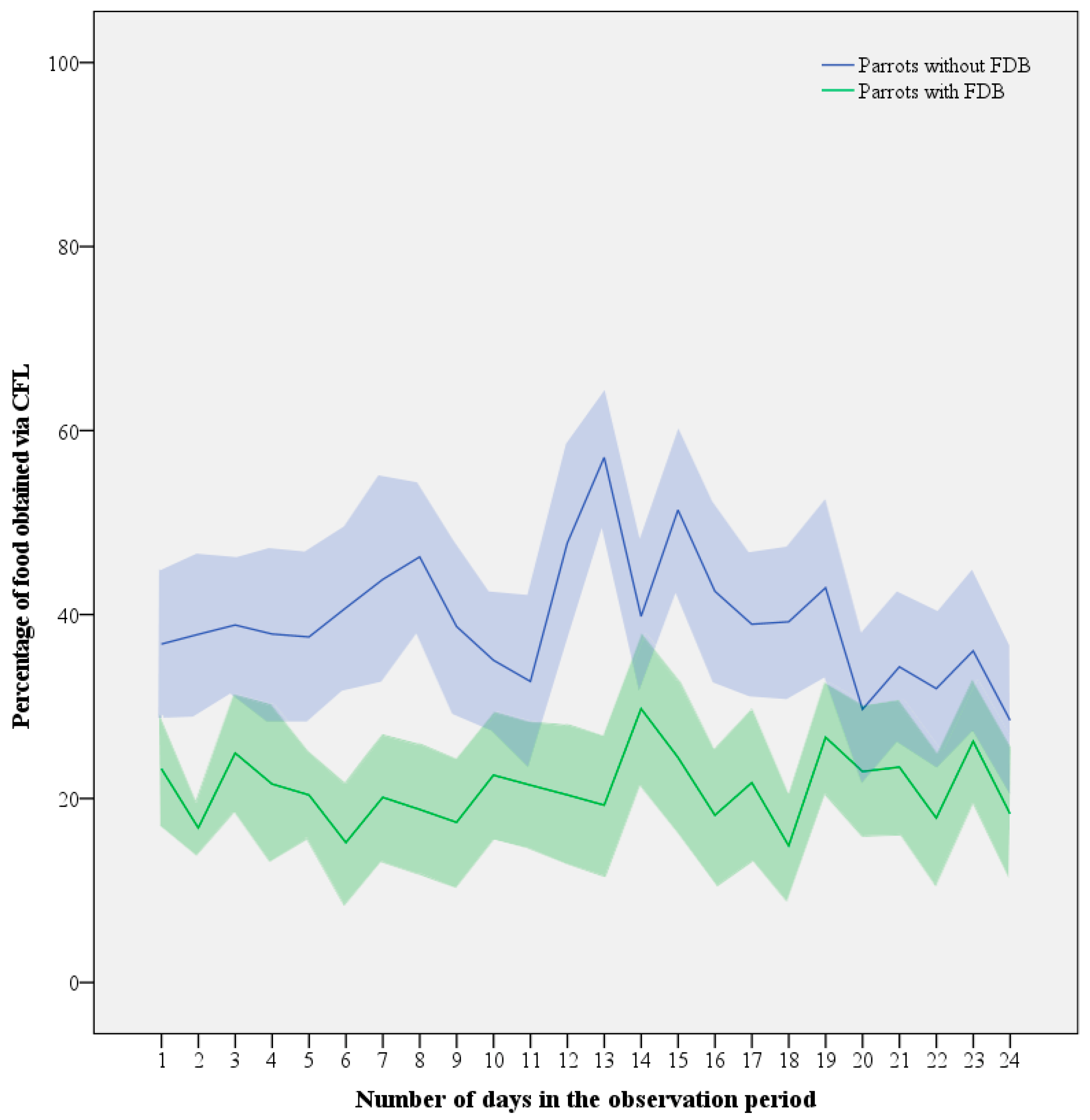
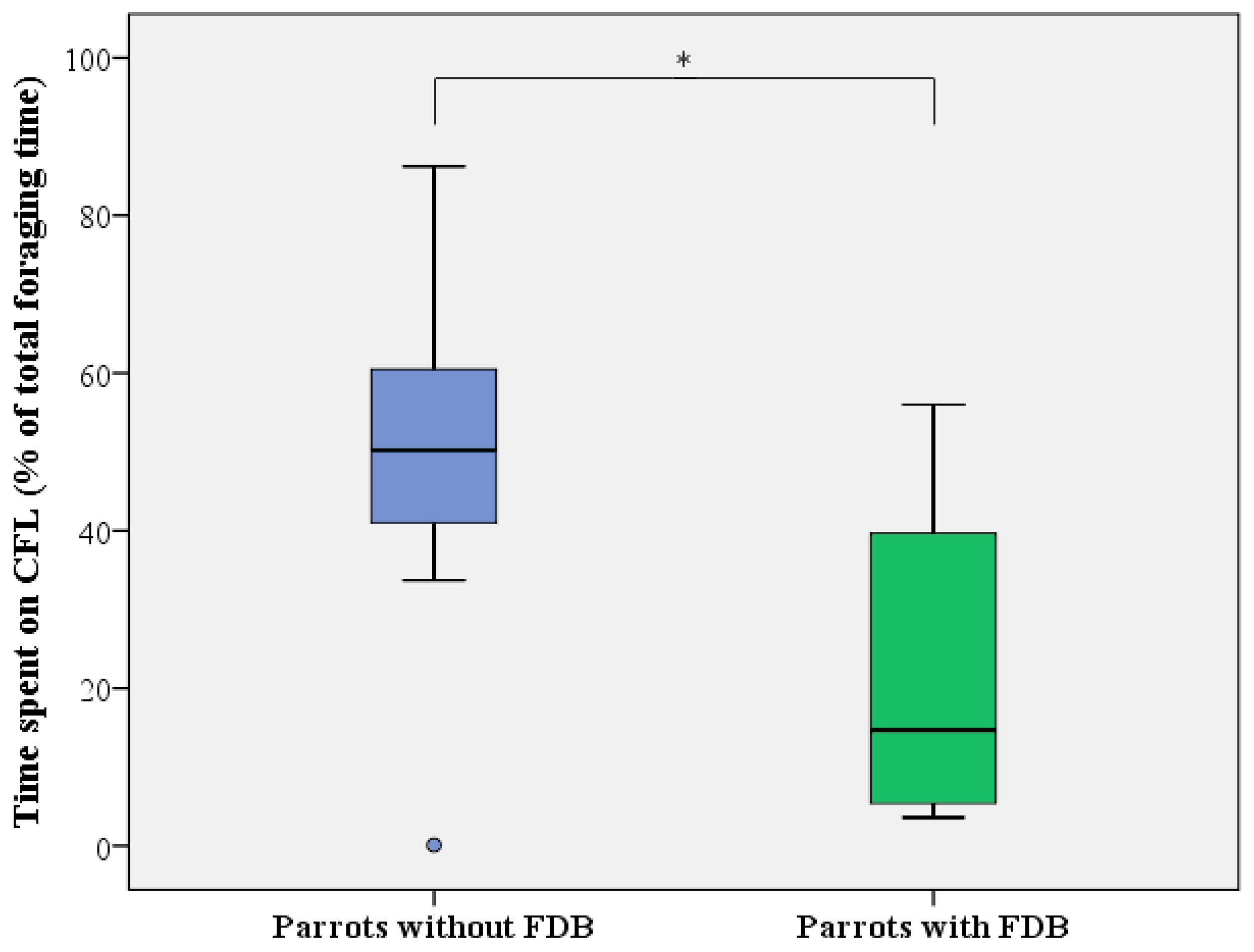
| Down Feathers | |||||
|---|---|---|---|---|---|
| No Down Removed | ≤50% of Down Removed | >50% of Down Removed | All Down Removed | ||
| Coverts | All coverts intact | 100 | 85 | 70 | 60 |
| Feather fraying or breakage | 95 | 80 | 65 | 55 | |
| <25% of coverts removed | 90 | 75 | 60 | 50 | |
| 25–50% of coverts removed | 80 | 65 | 50 | 40 | |
| 51–75% of coverts removed | 70 | 55 | 40 | 30 | |
| 76–90% of coverts removed | 60 | 45 | 30 | 20 | |
| >90% of coverts removed | 50 | 35 | 20 | 10 | |
| Parrot | Before | After | Change | CFL Percentage |
|---|---|---|---|---|
| 3 | 68 | 69 | +1 | 28.8 |
| 5 | 60 | 61 | +1 | 18.7 |
| 7 | 27 | 25 | −2 | 17.7 |
| 9 | 73 | 75 | +2 | 6.4 |
| 11 | 36 | 42 | +6 | 14.3 |
| 13 | 46 | 47 | +1 | 4.7 |
| 15 | 84 | 87 | +3 | 40.9 |
| 17 | 69 | 75 | +6 | 66.1 |
| 19 | 51 | 51 | 0 | 7.3 |
| 21 | 58 | 58 | 0 | 5.8 |
Disclaimer/Publisher’s Note: The statements, opinions and data contained in all publications are solely those of the individual author(s) and contributor(s) and not of MDPI and/or the editor(s). MDPI and/or the editor(s) disclaim responsibility for any injury to people or property resulting from any ideas, methods, instructions or products referred to in the content. |
© 2023 by the authors. Licensee MDPI, Basel, Switzerland. This article is an open access article distributed under the terms and conditions of the Creative Commons Attribution (CC BY) license (https://creativecommons.org/licenses/by/4.0/).
Share and Cite
van Zeeland, Y.R.A.; Schoemaker, N.J.; Lumeij, J.T. Contrafreeloading Indicating the Behavioural Need to Forage in Healthy and Feather Damaging Grey Parrots. Animals 2023, 13, 2635. https://doi.org/10.3390/ani13162635
van Zeeland YRA, Schoemaker NJ, Lumeij JT. Contrafreeloading Indicating the Behavioural Need to Forage in Healthy and Feather Damaging Grey Parrots. Animals. 2023; 13(16):2635. https://doi.org/10.3390/ani13162635
Chicago/Turabian Stylevan Zeeland, Yvonne R. A., Nico J. Schoemaker, and Johannes T. Lumeij. 2023. "Contrafreeloading Indicating the Behavioural Need to Forage in Healthy and Feather Damaging Grey Parrots" Animals 13, no. 16: 2635. https://doi.org/10.3390/ani13162635




